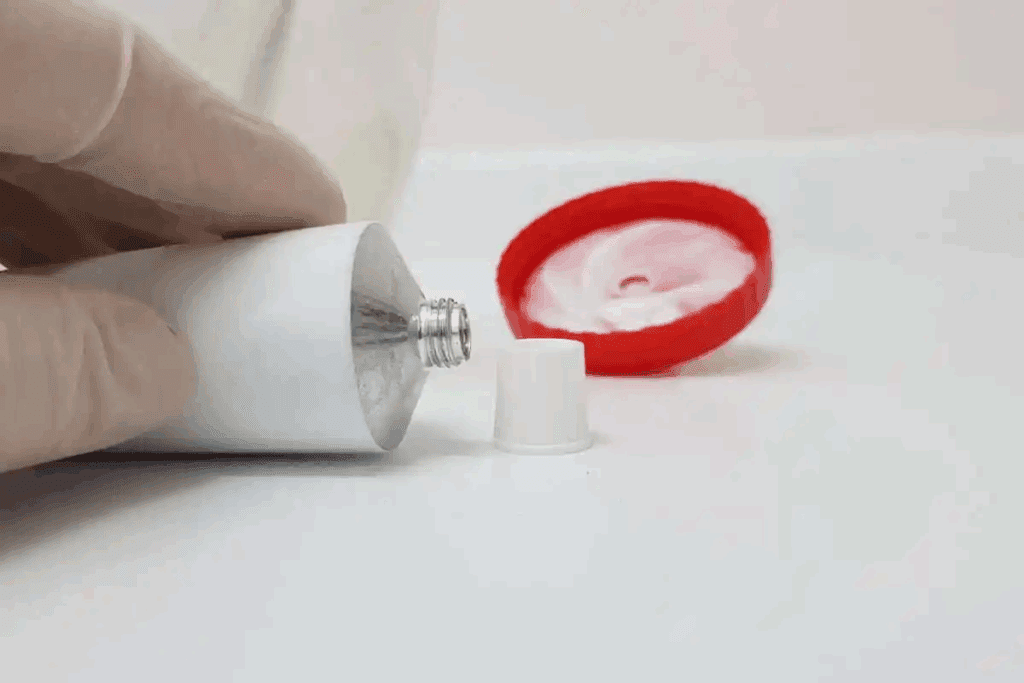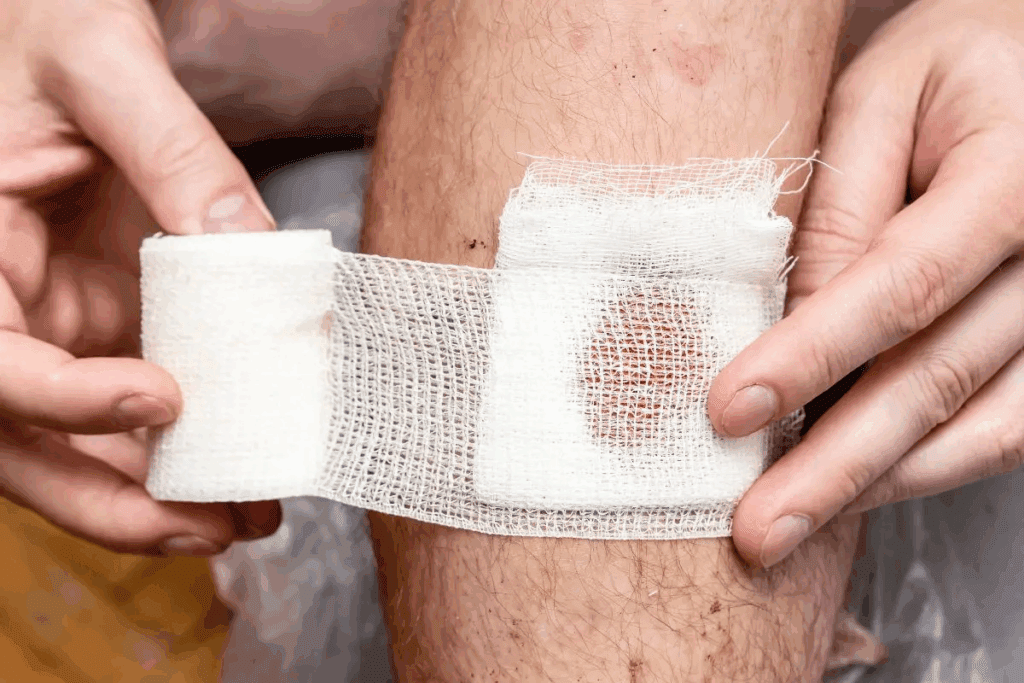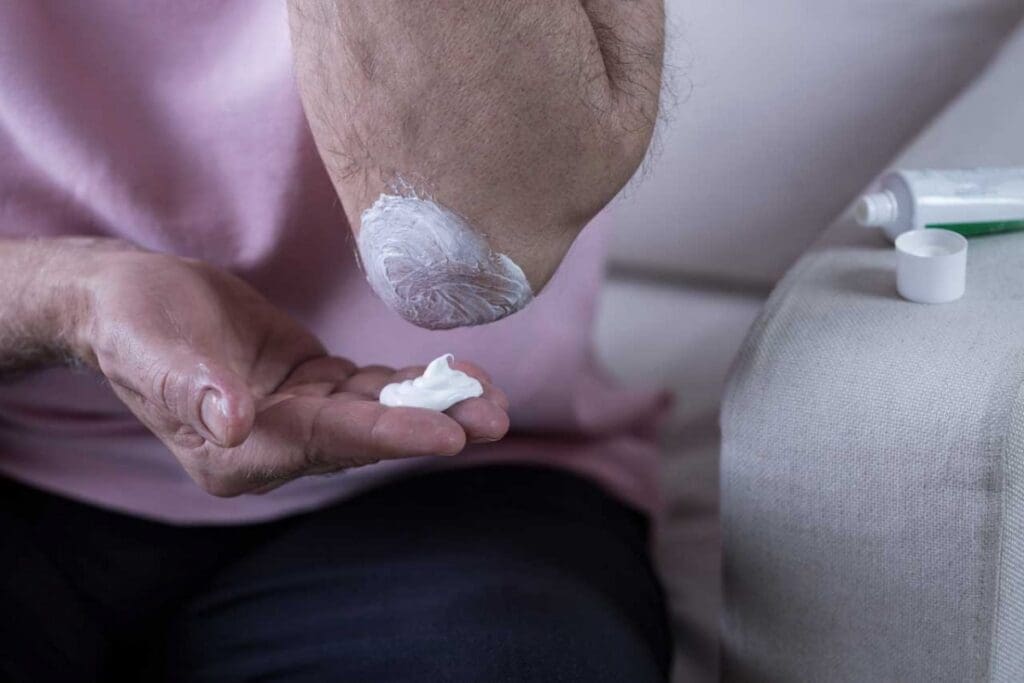Last Updated on November 26, 2025 by Bilal Hasdemir

Caring for stitches can be tough, like when you need to shower. At Liv Hospital, we know how key proper wound care is. Choosing the right ointment is key to keeping wounds moist, healing faster, and reducing scars. We suggest using petroleum jelly (Vaseline), Aquaphor, or antibiotic ointments as prescribed. These help keep your stitches moist and aid in healing.
Proper wound care is vital to avoid infections and ensure a smooth recovery. In this article, we’ll share important tips for picking the best ointment and showering safely with stitches. Our expert advice will guide you through the healing journey with confidence.

Knowing how wounds heal is key to caring for stitches. Healing wounds goes through stages like inflammation, proliferation, and remodeling. It’s important to care for wounds properly during these stages.
Stitches are important for healing. They close the wound, which helps prevent infection and speeds up recovery. By closing the wound, stitches also help reduce scarring.
Stitches help in many ways. They close the wound, which lowers the chance of infection. They also help the wound heal faster and reduce scarring.
Key benefits of stitches include:
Keeping the wound moist is important for healing. A dry wound heals more slowly and may scar more. But too much moisture can harm the skin around the wound and increase infection risk.
Balancing moisture is key: The right ointment helps keep the wound moist. This ensures it heals well.
Stopping infection is vital for wound healing. This means keeping the wound clean and using the right treatments. Also, watch for signs of infection. To avoid scarring, take good care of the wound and consider extra treatments.
Strategies for preventing infection include:
By understanding wound healing and proper care, we can help wounds heal quickly and well. This reduces the chance of problems.

The right ointment for stitches can greatly affect healing. It’s all about keeping the wound moist and preventing infection. This helps the stitches heal faster and better.
Petroleum jelly, or Vaseline, is a top pick for wound care. It keeps the skin moist and protects it from dirt and germs. It’s great for minor stitches because it’s easy to use and works well.
Aquaphor is another favorite for healing wounds. It keeps moisture in and helps fix dry skin. It’s perfect for stitches in dry or irritated areas.
Doctors might prescribe antibiotic ointments for stitches. These ointments fight off infections. They’re key for wounds at risk of getting infected.
Not all ointments work the same for every wound. Antibiotic ointments are best for high-risk wounds. Simple moisturizers like petroleum jelly are good for minor stitches.
Choosing the right ointment depends on the wound’s type and location. Always talk to a doctor for the best advice. They can guide you to the perfect ointment for your stitches.
Using wound ointments correctly is key to healing and avoiding infection. When you care for stitches, how you apply ointment matters a lot. We’ll show you the best ways to use ointments effectively.
Getting the right amount of ointment is important. Too little might not protect or moisturize enough. Too much can attract bacteria. A thin layer is usually enough to cover the wound without overwhelming it.
For most wounds, a small amount, like a grain of rice, is enough. The type of ointment you use also matters. For example, petroleum jelly (Vaseline) and Aquaphor should be applied thinly to keep the wound moist and help it heal.
How often you apply the ointment depends on the wound’s location and the ointment type. Wounds in dry areas, like hands or feet, might need more frequent application. Wounds in protected areas might need less.
Cleanliness is essential when applying ointment to stitches. Always wash your hands with soap and water before touching the wound or applying ointment. Use a clean cotton swab or applicator to apply the ointment to avoid introducing bacteria into the wound.
By following these guidelines, you can lower the risk of infection and help your stitches heal well. Remember, cleanliness and the right amount of ointment are key to effective wound care.
Healing after surgery or injury can be tough. Knowing when to keep stitches dry and when they can get wet is key. The first 24 hours are very important for healing.
In the first 24 hours, keep the stitches area dry. Moisture can bring bacteria, causing infection. Avoid baths, swimming, and be careful showering to not hit the stitches with water.
After 24 hours, check if your wound is ready for water. Look for signs like it’s not too moist, no infection signs, and it’s dry. If it’s okay, start with gentle showers. But, avoid soaking the stitches or using strong water.
Body areas differ in sensitivity and exposure. Stitches on the face or neck need extra care. Stitches on arms or legs might be okay, but they need protection too, like in bending areas. Always talk to your doctor for advice based on your wound’s location.
Following these tips helps your stitches heal properly and lowers the risk of problems. Always talk to your doctor if you’re unsure about caring for your stitches.
Showering with stitches needs careful planning to avoid infection and help healing. It’s not just about getting clean. It’s about keeping the wound safe. We’ll show you how to make sure your showering helps your recovery.
Before showering, make sure your area is clean to avoid risks. Clean the shower floor and walls with a mild detergent. Use a clean shower curtain or door. Have a clean towel ready for drying.
It’s important to protect your stitches while showering. You can use:
These methods keep your stitches dry, lowering the chance of infection.
The water temperature and pressure are key to comfort and healing. We suggest:
After showering, dry your wound carefully. Gently pat the area with a clean towel. Don’t rub or scrub the wound. If your dressing gets wet, change it to a new, dry one to keep the area clean for healing.
By following these safe showering tips, you can lower the risk of infection and help your wound heal. If you see any signs of infection or have concerns, call your healthcare provider right away.
The care for stitches changes a lot based on where they are. This includes the face, back, limbs, or feet. Each area has its own needs for healing well.
When you have stitches on your face, it’s important to handle them gently. Clean them with a mild soap and apply petroleum jelly or Aquaphor to keep them moist. Also, stay out of the sun and use sunscreen with at least SPF 30 when you’re outside.
Stitches on your back can be hard to take care of. Use a gentle cleanser and lukewarm water, then dry them by patting. When applying ointment, having someone help you is a good idea. Make sure not to hurt the wound or mess with the stitches.
Stitches on your arms and legs need a balance of care and movement. Keep them clean and moisturized, and don’t do too much that might hurt the wound. Raising the limb can also help with swelling.
Foot stitches need extra care because your feet carry your weight. Try to walk less and avoid putting pressure on the stitches. Keep your foot clean and dry, and use crutches or a walker if you need to.
| Body Area | Care Considerations | Precautions |
| Face | Gentle cleaning, moisturizing | Avoid direct sun exposure |
| Back | Difficult to reach, enlist help | Avoid irritating the wound |
| Arms and Legs | Balance protection and mobility | Avoid strenuous activities |
| Feet | Minimize walking, keep dry | Avoid direct pressure on stitches |
Deciding whether to cover stitches or not depends on several factors. These include the wound’s type and where it is. Knowing the benefits and drawbacks of each approach is vital for healing.
Covering stitches is key to keeping them clean from dirt and bacteria. This is very important for wounds in areas that get dirty easily. For example, stitches on hands or feet need covering to avoid irritation.
Choosing the right dressing is important. The dressing should let air in to help healing, but also keep bacteria out.
Choosing the right dressing material is important for healing. Here are some common ones:
| Dressing Type | Characteristics | Suitable For |
| Gauze Pads | Absorbent, breathable | Wounds with moderate drainage |
| Hydrocolloid Dressings | Creates a moist environment | Wounds with minimal drainage |
| Transparent Film Dressings | Waterproof, allows visualization | Wounds requiring observation |
While stitches need covering, sometimes air can help with healing. Air helps form a scab and dry the wound. This is good for some wounds.
But it’s important to find a balance. Leaving stitches uncovered too long can be risky, even in the early healing stages.
Finding a balance in wound care is key. This means considering the wound’s type, location, and healing stage. It might mean covering and then exposing the wound, or using dressings that breathe but protect.
Understanding the pros and cons of covering stitches helps promote healing. Making informed choices can reduce healing risks.
Dealing with accidents and complications is key to stitches healing properly. Even with careful planning, unexpected issues can pop up. Being ready to handle them is essential.
If your stitches get wet, act fast to avoid problems. Pat the area dry with a clean towel. Don’t rub or scrub the stitches. If the dressing gets wet, swap it for a dry one.
Key steps to follow:
Spotting infection signs early is critical. Look for redness, swelling, pain, or discharge around the stitches. If you see these, watch them closely and get medical help if they get worse.
Signs to watch for:
Knowing when to call your healthcare provider is important. If you see infection signs or have stitch concerns, reach out for advice.
Situations that require immediate attention:
If stitches are damaged, get emergency care fast. Quick medical help can stop more problems and help with healing.
Actions to take in an emergency:
Following the tips in this article helps stitches heal well and lowers the chance of problems. We talked about picking the right ointment, how to apply it, and safe showering. These steps help wounds heal better.
Good care for stitches means using these tips and watching out for accidents and infections. At Liv Hospital, we aim to give top-notch healthcare. We support international patients to help them heal well.
Using these best practices daily can help avoid complications and aid in healing. For more on stitches care and wound healing, talk to a healthcare expert. They can give advice tailored to you.
Petroleum jelly and Aquaphor are great for stitches. They keep the wound moist and help it heal. Sometimes, your doctor might prescribe an antibiotic ointment to prevent infection.
For the first 24 hours, keep stitches dry. After that, you can shower with them. But always follow your doctor’s advice and protect the wound.
Use a thin layer of ointment on facial stitches. Avoid direct water pressure when showering. Pat the area dry gently and follow your doctor’s care instructions.
If stitches get wet, dry them gently with a clean towel. If you see signs of infection, like redness or swelling, call your doctor.
How often depends on where your stitches are and what your doctor says. Usually, apply a thin layer 1-3 times a day, or as directed.
It depends on the stitches’ location and size, and what your doctor advises. Covering them protects them from dirt, but some wounds heal better with air.
Yes, Vaseline is good for keeping stitches moist. But always check with your doctor first.
Keep the wound clean and dry, and apply ointment as directed. Avoid water and watch for signs of infection. If you’re worried, call your doctor.
Look out for redness, swelling, pain, warmth, or pus. If you see these, call your doctor right away.
Showering with back stitches needs care. Avoid direct water and consider having help. Always follow your doctor’s post-shower care advice.
(2021). Benign tumors of the colon: Clinical and pathological features. World Journal of Gastroenterology, 27(45), 7761–7774.
Subscribe to our e-newsletter to stay informed about the latest innovations in the world of health and exclusive offers!